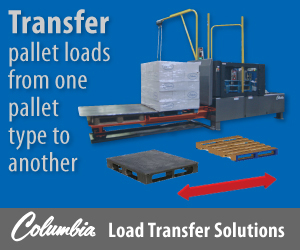MHI just released the 2016 MHI Annual Industry Report: Accelerating Change: How Innovation is Driving Digital Always-On Supply Chains to provide an up-to-date perspective on emerging supply chain technologies and trends.
|
MHI recently announced the winners of the 2016 MHI Innovation Award competition. These awards were announced during MHI Industry Night at MODEX 2016 in three categories: Best New Innovation, Best Innovation of an Existing Product and Best IT Innovation.
|
There is a sea change coming, one that will require retailers to respond. And when they do, they’ll no doubt be leaning heavily on companies throughout the supply chain to assist.
|
So, exactly how much economic impact does the supply chain have in the United States? Well, the answer is—we don’t really know all that precisely. Every year, the Council of Supply Chain Management Professionals (CSCMP) publishes its Annual State of Logistics Report. And the most recent edition says the cost of U.S. business logistics is 8.3 percent of U.S. GDP, or about $1.45 trillion. While that’s the number typically used, there isn’t much more available insight into answering the question. Fortunately, a major step toward developing specific economic impact metrics for the supply chain has been made by Dana Magliola, Lindsay Schilleman and John Elliott.
|
Having difficulty finding the necessary talent for your supply chain team? It’s time for a new approach. "The supply chain has evolved over the last decade or so into a complex orientation that combines a number of different traditional functions together and asks them to work together to not only operate the business for low cost but also to provide good service and to drive revenue," said Shay Scott, managing director of the Global Supply Chain Institute at The University of Tennessee. Supply chain employees today need significantly different skills than they did in the past, including the ability to see the big picture and to manage the increased risks and complexity in the global supply chain.
|
Although more than 11 million people work in the supply chain—representing 8.6 percent of the nation’s workforce— a shortage of skilled workers persists. An estimated 600,000 manufacturing positions in the United States are unfilled for a lack of qualified workers. Further, the U.S. Roadmap for Material Handling & Logistics predicts that by 2018 there will be 1.4 million new jobs in the field. As companies have struggled to find talent among their traditional workforce pool, they’ve begun to look elsewhere.
|


MODEX 2016 opened last week in Atlanta with over 800 exhibits and 250,000 square feet of manufacturing and supply chain solutions. Check out some of the news from this event.
|
Luis Castaneda was named the 2016 MHI Face of the Supply Chain during MHI Industry Night at MODEX 2016. Mr. Castaneda is Key Account Manager at Raymond Handling Concepts Corporation. Luis’ entry was titled "How the Supply Chain Saved My Life #iWorkInTheSupplyChain."
|
More than 11 million people work in the U.S. supply chain—that is 8.6 percent of the nation’s workforce. However, a shortage of skilled workers remains. Without a doubt, the skilled workforce shortage is the biggest challenge facing this industry.
|
Wearable technology, 3D printing, advanced robotics, real-time shipment tracking and integrated business planning tools are just a few examples of technologies that are in place now, or will be in the near future, throughout the supply chain. These advances have not only changed the way supply chain organizations do business, but they also present very real human capital challenges.
|
The outlook for U.S. economic growth and material handling for 2016 and 2017 has softened sharply in recent quarters. U.S. manufacturing activity fell to recession levels when it began contracting at the end of 2015, which can be seen in the year-over-year rate of industrial production and the ISM Manufacturing Index.
|


MHI view just released a new video on how 3D printing is revolutionizing the spare parts industry. In the video, David Roberts, core faculty at Singularity University, discusses how Singularity University graduates in a program called "Made In Space" were able to put a 3D printer on the international space station to 3D print in zero gravity. Specifically, to print parts that technicians might need.
|
Helping students understand the depth and variety of supply chain careers available can be as challenging as helping the industry’s companies understand the worth in reaching out. Collaboration between companies, universities, two-year colleges, high schools and government entities is key, for both the industry and the communities it serves.
|
Have you ever asked yourself how you started your supply chain career? You may be surprised by the answer. In my particular case, I was asked to "run the warehouse," mainly because no one else would do it. Imagine that—one of the key links in any supply chain and no one wanted to manage the warehouse. That was a long time ago, and at that moment, I recognized the need to look at supply chain careers in a different way.
|


Although well understood within the industry, the general public has—by and large—failed to recognize the significance of supply chain jobs to business and to the overall economy. The story needs to be told that supply chains are led by a diverse group of professionals who utilize innovation, creativity and smart thinking to keep the economy moving.
|
MHI—along with the Material Handling Equipment Distributors Association (MHEDA)—works closely with schools throughout the U.S. to support education in material handling, logistics and supply chain. Our programs help high schools, technical schools, community colleges, universities and other training organizations to build and sustain a skilled workforce that’s in high demand throughout our entire industry.
|
Ergonomic workstations bring the work to the workers by optimizing the fit between people, their tools, the task and their environment. Examples include raising tables or using tilting work surfaces. The goal is to avoid forcing operators to lean over to do their work using a poor posture that could result in low back and/or upper back discomfort.
|
|
| |
|